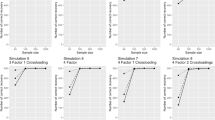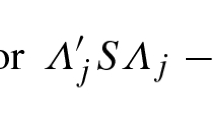Abstract
The relationship between the higher-order factor model and the hierarchical factor model is explored formally. We show that the Schmid-Leiman transformation produces constrained hierarchical factor solutions. Using a generalized Schmid-Leiman transformation and its inverse, we show that for any unconstrained hierarchical factor model there is an equivalent higher-order factor model with direct effects (loadings) on the manifest variables from the higher-order factors. Therefore, the class of higher-order factor models (without direct effects of higher-order factors) is nested within the class of unconstrained hierarchical factor models. In light of these formal results, we discuss some implications for testing the higher-order factor model and the issue of general factor. An interesting aspect concerning the efficient fitting of the higher-order factor model with direct effects is noted.
Similar content being viewed by others
References
Bentler, P. M. (1990).EQS: Structural equations program manual. Los Angeles: BMDP Statistical Software.
Ferguson, T. S. (1996).A course in large sample theory. London: Chapman and Hall.
Gorsuch, (1983).Factor analysis (2nd ed.). Hillsdale, NJ: Lawrence Earlbaum Associates.
Gustafsson, J., & Balke G. (1993). General and specific abilities as predictors of school achievement.Multivariate Behavioral Research, 28, 407–434.
Humphreys, L. G. (1981). The primary mental ability. In M. P. Friedman, J. P. Das, & N. O'Connor (Eds.):Intelligence and learning (pp. 87–102). NY: Plenum.
Humphreys, L. G., Tucker, L. R., & Dachler, P. (1970). Evaluating the importance of factors in any given order of factoring.Multivariate Behavioral Research, 5, 209–215.
Holzinger, K. J., & Swineford, F. (1937). The bi-factor method.Psychometrika, 2, 41–54.
Joreskög, K. G., & Sörbom, D. (1993).LISREL 8. Chicago: Scientific Software International, Inc.
McDonald, R. P. (1985).Factor analysis and related methods. Hillsdale, NJ: Lawrence Earlbaum Associates.
McDonald, R. P. (in press).Test theory: A unified treatment. Mahwah, NJ: Lawrence Earlbaum Associates.
McLeod, L. D., & Thissen, D. (1997). Models for composite tests. (submitted for review)
Mulaik, S. A., & Quartetti, D. A. (1997). First order or higher order general factor.Structural Equation Modeling, 4, 193–211.
SAS. (1990)SAS/IML (Version 6). Cary, NC: Author.
Schmid, J., & Leiman J. M. (1957). The development of hierarchical factor solutions.Psychometrika, 22, 83–90.
Tucker, L. (1940). The role of correlated factors in factor analysis.Psychometrika, 5, 141–152.
Wherry, R. J. (1959). Hierarchical factor solutions without rotation.Psychometrika, 24, 45–51.
Author information
Authors and Affiliations
Additional information
The authors would like to thank the reviewers for their useful comments for the revision of the manuscript. Requests for reprints should be sent to Yiu-Fai Yung, R52, Multivariate & Num. R&D, SAS Campus Drive, SAS Institute, Inc. Cary NC 27513.
Rights and permissions
About this article
Cite this article
Yung, YF., Thissen, D. & McLeod, L.D. On the relationship between the higher-order factor model and the hierarchical factor model. Psychometrika 64, 113–128 (1999). https://doi.org/10.1007/BF02294531
Received:
Revised:
Issue Date:
DOI: https://doi.org/10.1007/BF02294531




